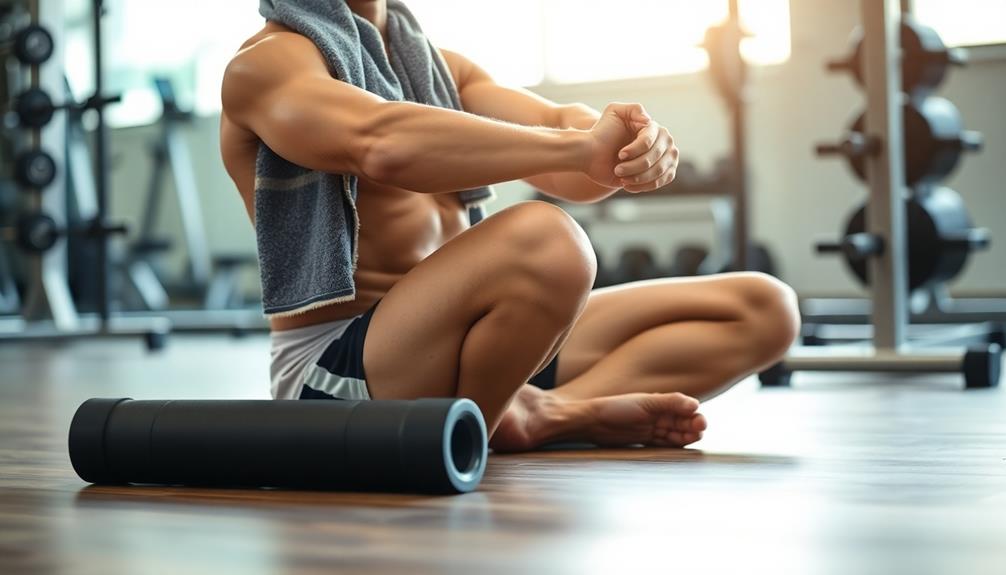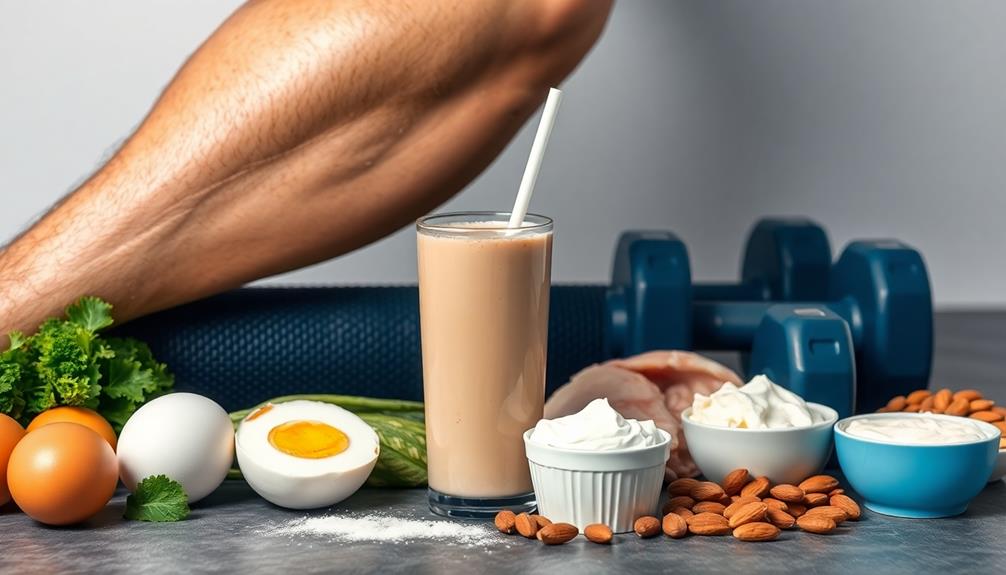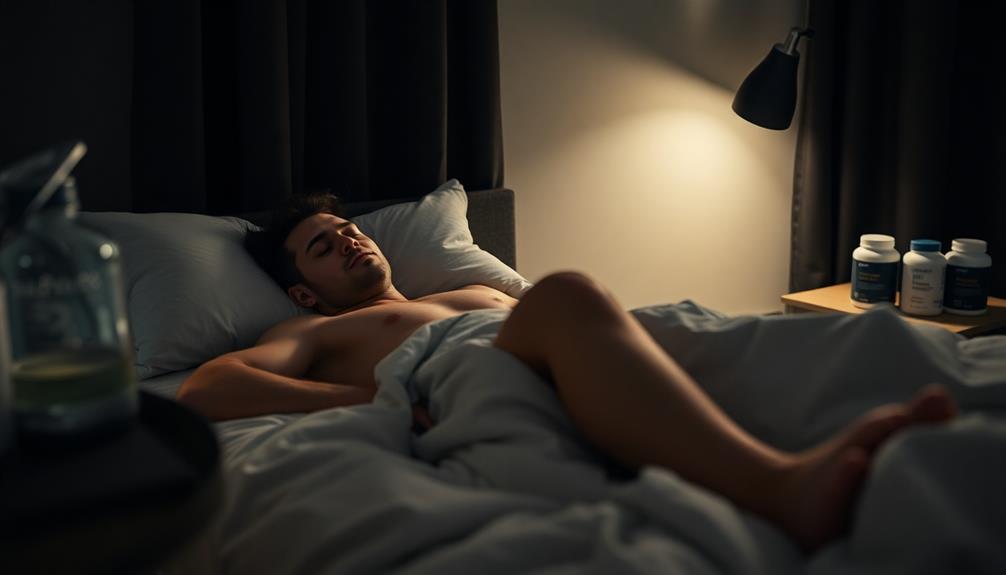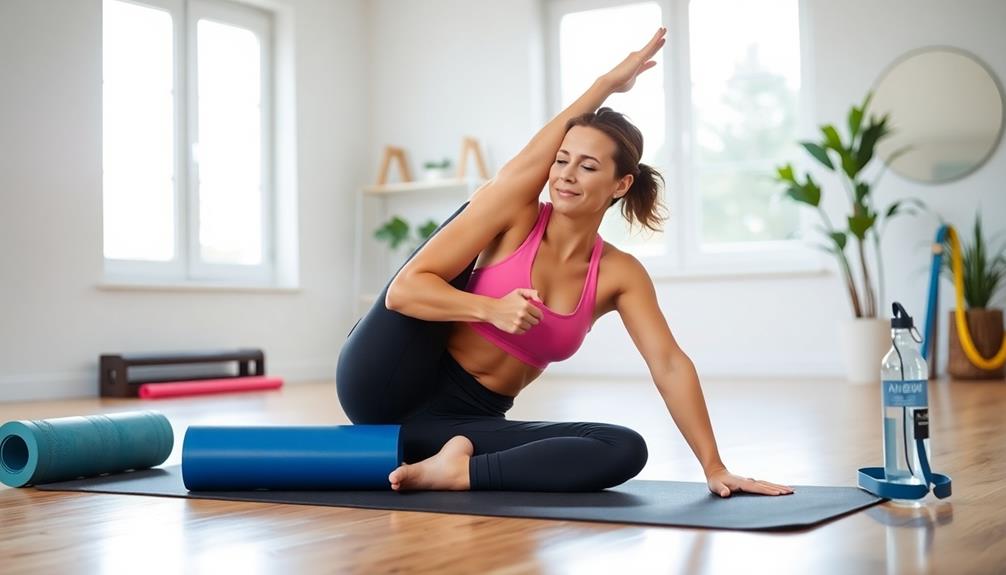After leg day, prioritize these seven recovery tips: Hydrate strategically by drinking water and replenishing electrolytes. Stretch and foam roll to alleviate muscle tightness. Consume protein-rich foods to support muscle repair. Apply ice therapy initially, then switch to heat after a day or two. Get 7-9 hours of quality sleep for overall recovery. Engage in light active recovery exercises to promote blood flow. Use massage and compression techniques to reduce soreness. By implementing these strategies, you'll optimize your post-workout recovery, reduce muscle soreness, and prepare your body for the next challenging session. Let's explore each tip in more detail to maximize your leg day recovery.
Core Insight
- Hydrate strategically with water and electrolytes to replenish fluids lost during exercise.
- Stretch and foam roll to alleviate muscle tightness and reduce post-workout soreness.
- Consume protein-rich foods or supplements within an hour of your workout to support muscle recovery.
- Apply ice therapy immediately after exercise to reduce inflammation, then switch to heat after 24-48 hours.
- Prioritize getting 7-9 hours of quality sleep to aid muscle repair and overall recovery.
Hydrate Strategically

Staying hydrated is key to recovering after a tough leg workout. You need to replace the fluids you lost through sweat and help your body heal. Drink at least 16-20 ounces of water within an hour of finishing your workout. If you exercised in the heat, taking salt pills can help you maintain electrolyte levels and avoid dehydration.
Keep drinking water throughout the day, as your body requires extra fluids to support muscle recovery. You can also add electrolytes to your water or drink a sports drink to replenish lost minerals.
Stretch and Foam Roll

Stretching and foam rolling help your muscles recover after a hard leg workout. They can make you less sore and more flexible. A foam roller pushes on your muscles, like a deep massage. Start by stretching gently for 15-30 seconds each, focusing on your thighs and calves. Then use the foam roller on tight spots, especially knots.
When you're done, you might feel:
- A good burn in your thigh muscles
- Your hamstrings loosening up
- Slight discomfort in your outer thigh
- Less tightness in your calves
- Your legs relaxing overall
Prioritize Protein Intake

Prioritizing protein is key for muscle recovery and growth after leg day. Your muscles need protein to repair and rebuild right after an intense workout. Protein powders high in protein and with all the essential amino acids, especially BCAAs and leucine, are great for post-workout recovery.
Try to have a protein-rich meal or snack within an hour of your workout. Good options are lean meats, fish, eggs, dairy, or plant proteins like legumes and tofu. A protein shake works well if you're in a hurry.
How much protein you need post-workout depends on your weight and how hard you trained. Generally, aim for 20-30 grams of protein. This gives your muscles the amino acids they need to recover faster and get stronger.
Ice and Heat Therapy

After an intense leg workout, apply ice for 15-20 minutes to reduce swelling and inflammation. Ice baths work well for recovery after tough sessions. Switch to heat therapy after a day or two to boost blood flow and help your muscles recover.
During ice therapy, you'll feel a cold, numb sensation. Heat therapy will make your muscles feel warm and relaxed. Icing reduces swelling and stiffness, while heat improves flexibility. If you use both, you'll feel alternating sensations of cold and warmth.
Get Sufficient Sleep

Sleep is essential for recovering from exercise, especially after an intense workout. During sleep, your body fixes and grows muscle. Aim for 7-9 hours of good sleep each night. Make your bedroom cool, dark, and quiet. Avoid using screens before bed, as the light can mess with your sleep.
Sleep has many benefits for recovery:
| Sleep Benefits | Impact on Recovery | How to Improve |
|---|---|---|
| Muscle repair | Faster healing | Consistent schedule |
| Hormonal balance | Reduced inflammation | Comfortable bedding |
| Mental recovery | Improved performance | Limit caffeine intake |
| Injury prevention | Enhanced muscle growth | Pre-sleep relaxation |
Focus on both how long you sleep and the quality of your sleep. Stick to a regular sleep schedule, make sure your bed is comfy, cut back on caffeine, and do something relaxing before bed. These tips will help you get the most out of your sleep and recover better from your workouts.
Active Recovery Exercises

Sleep is key for recovery, but staying active between workouts also helps you heal. Active recovery exercises boost blood flow, reduce soreness, and keep you flexible. You don't need to push hard – just keep moving gently. Some good active recovery exercises for leg day:
Light jogging or brisk walking
Swimming or water aerobics
Yoga or gentle stretching
Easy cycling
Simple bodyweight exercises
These get your blood pumping without overworking your muscles. Aim for 20-30 minutes of light exercise on rest days. Go at your own pace and listen to your body. Active recovery shouldn't feel like another hard workout. It's about keeping you moving while your muscles repair. Adding these exercises supports your body's natural recovery and gets you ready for your next leg session.
Massage and Compression Techniques

Massage and compression can help you recover faster after leg day. Use a foam roller or massage ball to roll your quads, hamstrings, and calves for 30-60 seconds each. This releases tension and improves blood flow.
Wear compression socks or leggings for a few hours post-workout. They reduce swelling and soreness by putting pressure on your legs to boost circulation. When buying compression sleeves, think about the material, size, and how you'll use them. This ensures they work well and feel good.
A professional sports massage targets tight muscles and flushes out waste. You can also use a massage gun on your legs. Start at a low intensity and slowly increase as needed.
Frequently Asked Questions
How Long Should I Wait Before Doing Another Leg Workout?
You should typically wait 48-72 hours before doing another leg workout. This allows your muscles to recover and rebuild. However, if you're still experiencing significant soreness, it's best to wait until it subsides before training legs again.
Can I Take Over-The-Counter Pain Relievers for Post-Workout Soreness?
You can take over-the-counter pain relievers for post-workout soreness, but use them sparingly. They may help reduce pain and inflammation, but they can also mask important signals from your body. Consider natural alternatives first when possible.
Are There Specific Supplements That Can Help With Leg Recovery?
Yes, you can try supplements to aid leg recovery. Consider using protein powder, BCAAs, creatine, and omega-3s. They'll support muscle repair and reduce inflammation. Remember to consult a healthcare professional before starting any new supplement regimen.
Should I Avoid Stairs or Walking Long Distances After Leg Day?
You shouldn't avoid stairs or walking after leg day. Light movement can actually aid recovery by promoting blood flow. However, listen to your body and don't overdo it. If you're in pain, take it easy.
How Can I Reduce Muscle Cramping After an Intense Leg Workout?
To reduce muscle cramping after an intense leg workout, you'll want to stay hydrated, stretch properly, and consume electrolytes. You can also try massaging the affected areas, taking a warm bath, or using a foam roller for relief.

